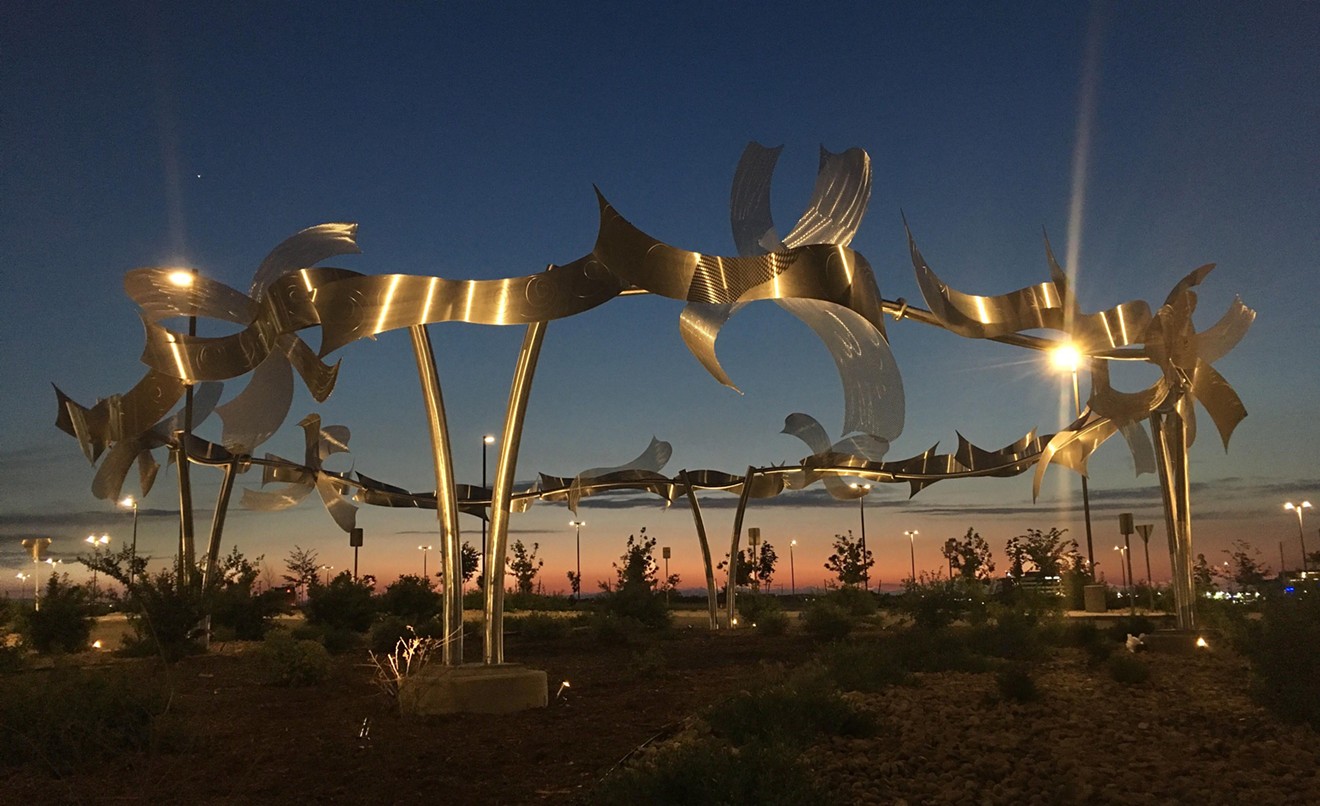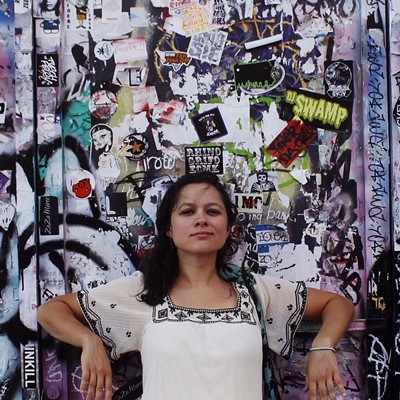On January 8, 2004, Robb suffered a massive stroke that rendered him mostly mute and completely paralyzed on the right side of his body. Robb's doctors told his family not to get their hopes up. Other longtime supporters thought it was the end of Robb's promising career, and several galleries stopped showing his work.
Indeed, the stroke marked the end of one chapter of his life, but it also commenced a new journey. The sculptures Robb produces today are not only his largest, most complex works to date; they're also his primary means of communicating with the world.
A third-generation Coloradan, Robb grew up in a home surrounded by art. His mother taught piano, and his brother Craig carved out his own reputation as a sculptor. Robb married his Boulder High School sweetheart, Diane. For the first three years of their marriage, the couple lived on a homestead twenty miles north of Limon. There Robb started welding old farming equipment, turning it into works of art.
Determined to become an artist, Robb studied graphic design under Philip Steele at the Rocky Mountain College of Art and Design in the late ’70s.
“Phil would always talk about how you need to know the basics, and if you know the basics, then you can move forward. But when artists get in trouble, it’s because they skip those stages,” Diane recalls. “That's why Phil would always teach drawing of the human body. He would say, 'You can’t get more basic than the human body,' and so Kevin has all these sketches [from] Phil’s classes of the human body.”
After graduation, Robb apprenticed under Colorado sculptor Doug Wilson, who offered him his first spot in a sculpture show. (Wilson passed away in 2011.)
“So Kevin created an eighteen-inch sculpture, and they laughed at him and said, ‘Yeah, that’s a nice design, but make it eighteen feet, and make it worth your while,’" Diane recalls. "And from then on, all Kevin wanted to do was create big pieces.”
Though sun-baked and pockmarked by hail, that first monolith still stands in the Kevin Robb Sculpture Garden at his Wheat Ridge home.
“From there, Kevin grew the business. I worked corporately and shared with him that I had no intention of supporting a starving artist," says Diane, who had her own satisfying and successful career in health-care administration. "He said, 'Have a little faith. I’ll make it work,'" and he has supported the family for the past twenty-plus years.
“It was total dedication. He would always be in the studio working or in the office working on the business,” Diane says. “In those earlier days, when all his buddies would get together on Thursday afternoon, they would meet at My Brother’s Bar and talk art and whatnot, and he stopped going, because he said, ‘No. That could be hours in the shop. That could be hours in the studio working on my art.’”
Robb’s hard work paid off. Alongside Robert Mangold, he became one of the the first non-representational artists allowed to exhibit in Loveland’s annual Sculpture in the Park show. From France to Australia to 48 states, Robb sold works around the world.
He enjoyed playing with new materials and found inspiration in everyday life. After visiting Japan in the mid-’80s, Robb's straight-line works began embracing bends. When his daughter Kelsey was young, Robb created a series of letters inspired by her wooden blocks.

Kelsey Robb stands inside one of her father's newly installed sculptures in the mid-1990s.
Kelsey Robb
One January day in 2004, without warning, everything stopped. Diane found her husband on the studio floor. He had suffered a massive stroke. Kevin Robb was put on life support, and the doctors told his family to make their peace with his impending death. No one expected him to survive the first 24 hours.
"Of the dozens of doctors we’ve seen, no one can tell us why the stroke occurred or why he’s still alive. There’s no reason, no logic, no explanation to any of it," wrote Kelsey in a Facebook post, looking back on the fourteenth anniversary of the stroke. Kelsey found profound meaning in this date, because she was fourteen years old when she nearly lost her father.
Robb spent thirteen days in the hospital and then was transferred to a rehab facility for seven weeks. Nearly two months after it all began, Robb was moved back to his home in Wheat Ridge.
“When he came home, he wasn’t there,” Diane says. “You know how you look at somebody and they’re not there? And we really had no idea what we had on our hands."
Eventually, Diane and Kelsey decided to bring Robb back to his workshop. He couldn't open a sketchpad, much less handle a blowtorch, but his wife and daughter knew how much his work had meant to him. Together they helped him cross the yard and open the door to his studio.
"The minute he crossed that threshold, there was life in his eyes," Diane says. "And I knew then this would be his recovery."
And so Robb rehabilitated himself by relearning the thing that came most naturally to him: making art.
"At first he would want to go into the studio every day and just stand there, even if all he could do it for was a few minutes," Diane says. Robb had often contracted welders and artisans to help build larger pieces, and so he watched them complete the commissions he had left unfinished.
"Slowly, slowly, he would be shaking his head yes or no, shaking his cane trying to communicate," Diane says.
Robb taught himself the 3-D graphics program SketchUp and began designing new works. Throughout 2005, he produced 22 original sculptures, from small tabletop decorations to a sixteen-foot work.
"It was as if Kevin couldn’t create fast enough," Diane recalls.
Despite how far he has come, Robb never fully recovered from the stroke and never will. He continues to be unable to move the right side of his body and walks with a cane.
“I think that people underestimate how challenging it is for him to still get out into the studio every single day," Kelsey says. "Yes, it’s his love, but he only has one half of his body. I think sometimes it can get sugarcoated. It’s like, 'Aw, how sweet,' but no. It is something much more deep than that. It is this deep passion that nothing will keep him from doing that, and it's hard, and he's in a lot of pain."
It's also impossible to understate the difficulty of a nature-loving Coloradan losing his ability to enjoy the outdoors as he once did. In his youth, Robb would ditch high school and hitchhike out to ski Eldora. His ideal vacation was working on his cousin's horse ranch.

Kevin Robb, left, and his daughter Kelsey still escape to the mountains whenever they can.
Kelsey Robb
“Case in point, one time after your stroke, you decided you needed to go out to Samuel,” says Diane to her husband, referring to the metal manufacturer Robb has long used as a supplier. “Well, I had no idea where we were going, and he couldn’t tell us, but he would say through charades that we had to get in the pickup truck and go some place.”
Following her husband’s mimed directions, Diane remembers pulling up to the steel mill thinking, “This is going to be awkward, because we’re going to walk in, and I don’t know what I’m doing here. And we walked in, and everybody knew him so well that they all stopped production and came running over and gave Kevin big hugs.”
Diane left her health-care work to run Robb's studio. She speaks with clients, reporters and contracts assistants, and writes the studio's blog posts, but Robb remains the creative force behind it all. No one knows exactly how he designs his sculptures or even how he knows they're going to stand.
Nevertheless, he's currently undertaking his most complex pieces to date. Over the last year, he designed and installed the 136-foot-round "Kite Festival" in the Denver Business Park and "Dancing in the Sun," a thirty-foot-tall piece that towers over Interstate 5 in the Gateway at Torrey Hills north of San Diego.
Over the decades, Robb’s style evolved from linear lines and straight edges to designs that danced and curved. When asked if his style has changed since the stroke, Robb’s face lights up, and he says, “Yes. Yes.”
“Everything is a lot more curvy," Diane adds. "There’s a lot more action in the pieces."
Kelsey says her father has always been a master of playing with perspective. She displays her own favorite piece in the entrance of her home. It's called "Out of the Box" and was one of the last pieces he created in 2003.
"The reason I love it so much is my day-to-day job is very analytical," says Kelsey, who works in marketing analytics. "I’m dealing with billions and billions of rows of data, so everything I do in my life is very linear, but everything he taught me was you can have these straight lines, you can have these boxes, but just a little bit of a different perspective changes everything. All it takes is that one piece to be a little bit different, and everything else is different about it."

Kelsey Robb keeps her father's 2003 sculpture "Out of the Box" in the entrance of her home.
Kelsey Robb
“Kevin’s career has grown since his stroke, but we have always said he is a sculptor who happens to be disabled," Diane explains. “A lot of people who collect Kevin’s work have no idea; they just like his work."
To fully appreciate the evolution of Robb’s work from representational studies to the quirky colored calypsos and his textured fabricated bronze, make an appointment to visit the Kevin Robb Sculpture Garden in Wheat Ridge by calling 303-431-4758.



















